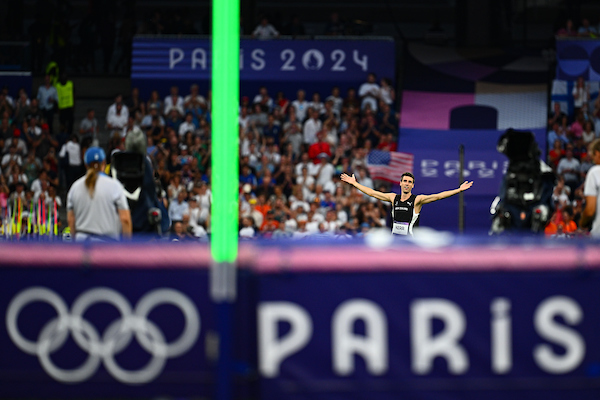MEET MR. HAMISH KERR:
THE 31ST MEN’S OLYMPIC
HIGH JUMP CHAMPION.
HOW HE LEAPED
TO GOLDEN GLORY
AND WHAT IT REPRESENTED.
BY ELLIOTT DENMAN / WITH DWIGHT STONES
Kerr-rect me if I’m wrong, but the newly-throned men’s Olympic
high jump champion, Mr. Hamish Kerr is (all at once):
(a) The 31st different champion of an event that has been staged
31 times.
(b) The first New Zealand male track and field athlete to strike gold at the
Games since John Walker ran off with the 1500 meters at Montreal in 1976.
(c) The first male athlete from the Southern Hemisphere to win the
Olympic HJ since John Winter of Australia in London in 1948.
(d) The first Kerr-named male Olympian to strike Olympic
track and field gold since Bobby Kerr of Canada dashed to the 200-meter title
at London in 1908.
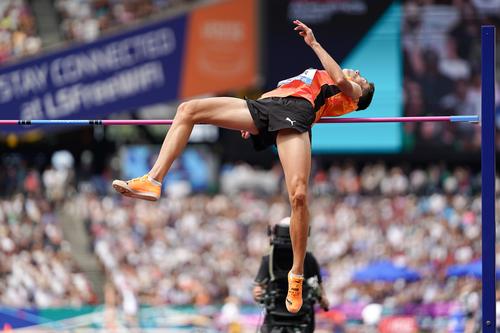
(e) Sorry, Mr. Josh Kerr of Team GB, USA’s Cole Hocker got to his 1500th Paris meter all of 14/100th of
a second before you.
(f) Sorry, too, past American golden guys Sabin Carr (1928 pole vault); Bill Carr (1932 400, 4×400); Henry Carr (1964 200, 4×400) – sure, you sound close, but C-a-r-r doesn’t spell K-e-r-r.
(g) The first Hamish-named fella from New Zealand to claim Olympic gold since
rower Hamish Bond pulled a mighty oar for the NZ eight at Tokyo 2021.
(h) And to do all this, he had to fight off American challenger Shelby McEwen, in the form of his life, as well as the illustrious Mutaz Essa Barshim of Qatar, now the Games’ first (and only) four-time HJ and full-set medalist (silver London 2012 and Rio 2016), co-gold with Gianmarco Tamberi of Italy (Tokyo 2021), now bronze (Paris 2024.)
All that said, let me now hand off to Mr. Dwight Stones, Mr. High Jump himself:
Nineteen-time National Champion; three-time world record-breaker; three-time Olympian, two-time Oly bronze medalist (Munich 1972, Montreal 1976.) And – for sure, for sure – for decades, one of the sport’s best–ever broadcasters and keenest analysts.
So here’s how Mr Dwight Stones saw it go down (er, we mean up):
“ Going into the 2024 Olympic high jump competition, I felt like Hamish Kerr of New Zealand was coming in with the best yearly record and that he was capable of matching or exceeding his NR/PR of 2.36m (7’8 3/4”) in order to win the Gold.
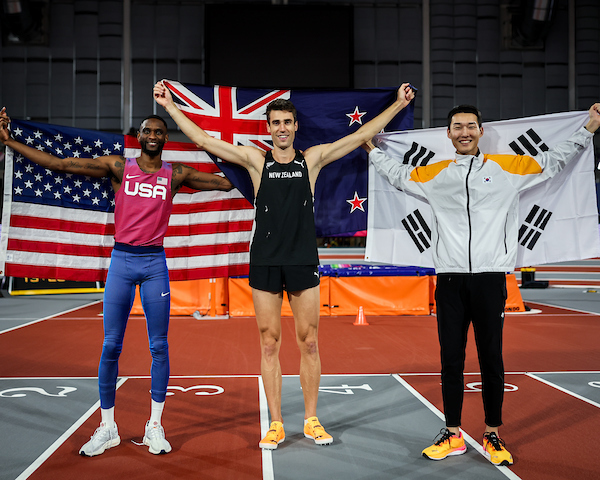
“ Defending champions Mutaz Essa Barshim of Qatar and Gianmarco Tamberi of Italy, both 31 years old, and both turned up with injuries/illnesses in the last weeks leading up to Paris including Barshim withdrawing from the final Diamond League event in London with a recurring calf problem which flared during the qualifying round. Tamberi had jumped exceedingly well in winning the European Championship in June but had since picked up an injury and was hospitalized the week prior to the Olympics with kidney stones.
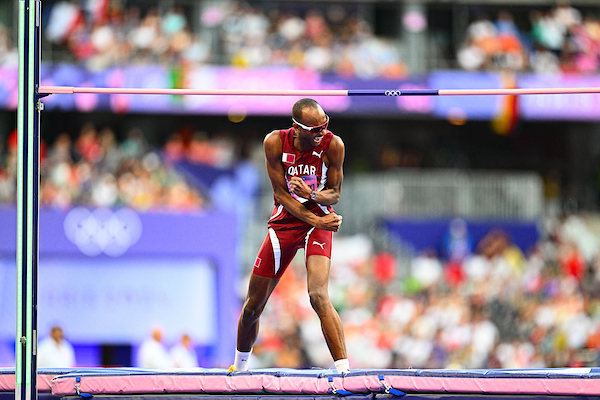
“Remember that no male high jumper has ever repeated as Olympic high jump champion. I also felt that American Shelby McEwen was capable of getting on the podium if he could stay miss- free through his SB/PR of 2.33m (7’7 3/4”) or thereabouts. I also believed Woo Sang-hyeok of Korea could be competitive based on his performance in Tokyo .
“The competition moved quickly due to the choice of heights by the Games Committee. All the jumpers in the final cleared a height including Tamberi who came into the competition at 2.22m (7’3 1/4”) and cleared on his third attempt. That morning, he had put out on social media that he was withdrawing from the final and going back to the hospital. I was amazed to see him jumping in warm-ups. But he couldn’t manage any higher than his opening height.
“Barshim was jumping near the top of the order and was flawless through 2.34m (7’8”) which had him in the lead. Kerr looked far too casual and sloppy to me through 2.27m (7’5 1/4”) which led to two misses at 2.31m (7’7”), but his third attempt clearance seemed to re-energize him.
“ McEwen was miss-free through that height but PR’d on a huge third attempt clearance at 2.34m (7’8”) to stay in the medal hunt.
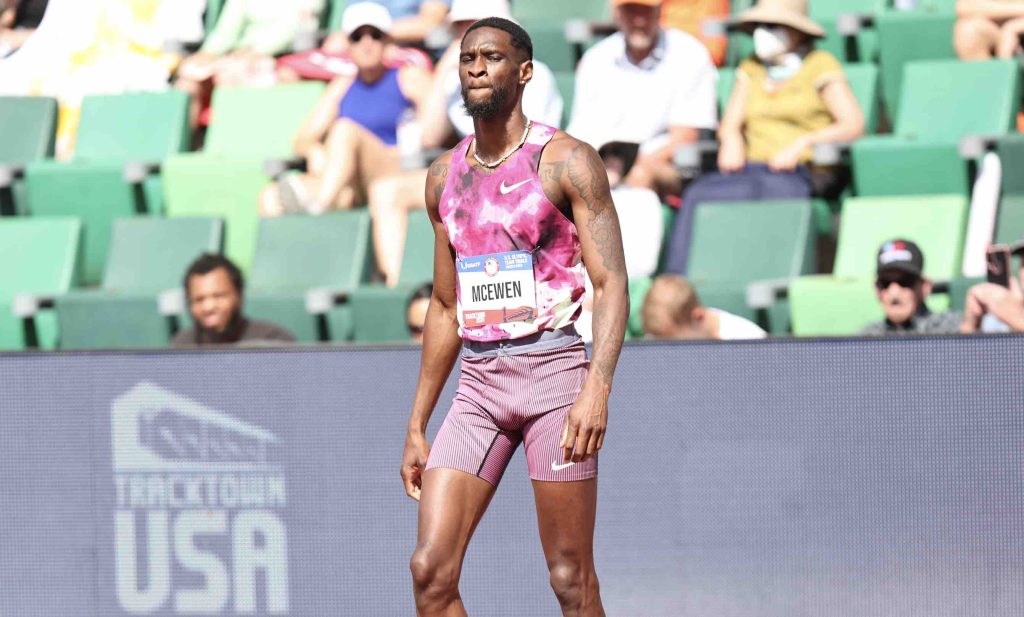
“The crossbar was raised to 2.36m (7’8 3/4”) with four jumpers remaining and Barshim, first in the jumping order now, in the lead until his first miss of the competition. Kerr and McEwen surprised with first-attempt clearances at that height, another PR for the American and a PR/NR match for Kerr. Stefano Sotile of Italy was the fourth jumper in the mix and he had PR’d at both 2.31m and 2.34m but 2.36m was too big an ask.
“Frankly, I was amazed when Barshim didn’t pass to 2.36m after his first miss seeing as two jumpers cleared right after him. A clearance at 2.36m would do nothing for him other than give him three attempts at the next height. He missed badly on his second attempt at 2.36m and chose to pass his remaining jump to the next height. Because he had no misses through 2.34m, he was in no worse than bronze position.
“The bar went up to 2.38m (7’9 3/4”) and Barshim’s one effort was not close and he settled for bronze. McEwen and Kerr were exactly tied at this point as both had cleared 2.36m on their first attempts and they both had two misses prior to that.
“The American was now jumping first in the order, a huge advantage for the Kiwi. But only Kerr’s second jump was decent and now the two warriors were faced with the same dilemma as Barshim and Tamberi in Tokyo: To jump-off or to not jump-off, that was the question.
” Do they share the gold like the Qatarian and the Italian from 2021 or do they fight to the competitive death, one earning gold, the other silver ?
“ It appeared that McEwen wanted to continue but I have people in the know who told me Kerr would never accept a share. Whichever way it was, the jump-off was on.
“McEwen, up first in the order, took his one jump at 2.38m and it wasn’t close, same for Kerr. The bar was lowered to 2.36m and the same outcome although Kerr’s attempt was superior to McEwen’s. The bar is lowered once again, this time to 2.34m. McEwen’s legs were clearly dead and Kerr sailed over easily and embarked on a victory jog around the infield.
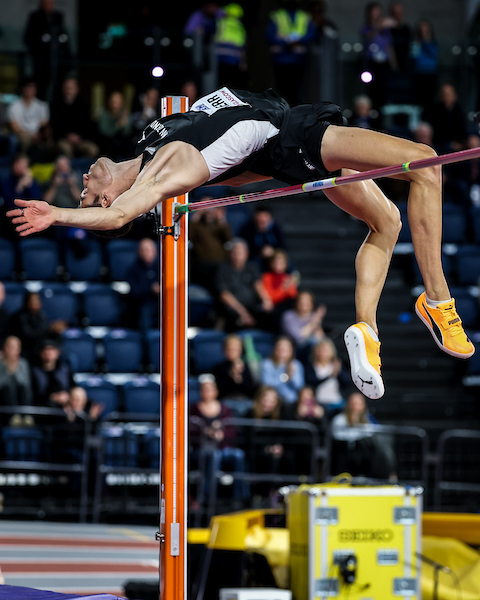
“Kerr is 27 years old (he’d turn 28 on Aug. 17), one year younger than Barshim and Tamberi were in Tokyo. He’ll be 31 in Los Angeles (which would be his third Olympics), the same age the Qatarian and the Italian were in Paris.
“Can he stay healthy and engaged enough to be the first man to successfully defend his well-earned title? Only time will tell.”
xxxxx
Signing off now, Elliott Denman, whose Olympic event in 1956 required continued contact with the ground.
Author

One of the finest and most prolific writers in our sport, Elliott Denman has written about our sport since 1956, when he represented the US in 1956 Olympic Games at the 50k race walk, the longest event on the Olympic schedule. A close observer of the sport, Elliott writes about all of our sport, combining the skills of a well honed writer with the style of ee Cummings. We are quite fortunate to have Elliott Denman as a friend and advisor.
View all posts

